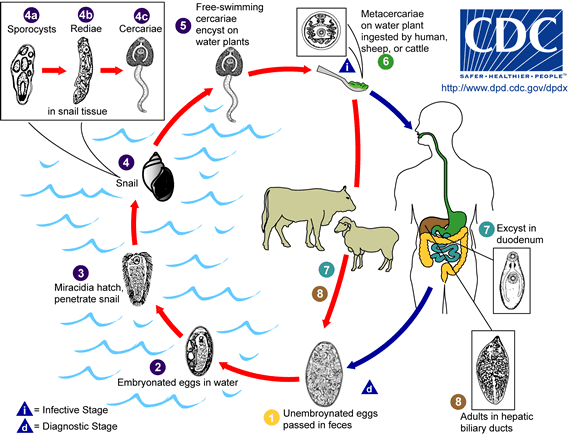| |
Immature eggs are
discharged in the biliary ducts and in the stool
 .
Eggs become embryonated in water .
Eggs become embryonated in water
 , eggs
release miracidia , eggs
release miracidia
 , which
invade a suitable snail intermediate host , which
invade a suitable snail intermediate host
 ,
including many species of the genus Lymnae. In the snail the
parasites undergo several developmental stages (sporocysts ,
including many species of the genus Lymnae. In the snail the
parasites undergo several developmental stages (sporocysts
 , rediae , rediae
 , and
cercariae , and
cercariae
 ). The
cercariae are released from the snail ). The
cercariae are released from the snail
 and
encyst as metacercariae on aquatic vegetation or other surfaces. Mammals
acquire the infection by eating vegetation containing metacercariae. Humans
can become infected by ingesting metacercariae-containing freshwater plants,
especially watercress and
encyst as metacercariae on aquatic vegetation or other surfaces. Mammals
acquire the infection by eating vegetation containing metacercariae. Humans
can become infected by ingesting metacercariae-containing freshwater plants,
especially watercress
 . After
ingestion, the metacercariae excyst in the duodenum . After
ingestion, the metacercariae excyst in the duodenum
 and migrate through the intestinal wall, the peritoneal cavity, and the
liver parenchyma into the biliary ducts, where they develop into adults
and migrate through the intestinal wall, the peritoneal cavity, and the
liver parenchyma into the biliary ducts, where they develop into adults
 . In
humans, maturation from metacercariae into adult flukes takes approximately
3 to 4 months. The adult flukes (Fasciola hepatica: up to 30 mm by
13 mm; F. gigantica: up to 75 mm) reside in the large biliary ducts
of the mammalian host. Fasciola hepatica infect various animal
species, mostly herbivores. . In
humans, maturation from metacercariae into adult flukes takes approximately
3 to 4 months. The adult flukes (Fasciola hepatica: up to 30 mm by
13 mm; F. gigantica: up to 75 mm) reside in the large biliary ducts
of the mammalian host. Fasciola hepatica infect various animal
species, mostly herbivores.
|
|
